Table Of ContentE P
STIMATION OF ARAMETERS
A P
FOR NIMAL OPULATIONS
ii
iii
∞
Estimation
of Parameters
for Animal
Populations
∞
A PRIMER
FOR THE REST OF US
∞
L A. P
ARKIN OWELL
AND
G A. G
EORGE ALE
Caught Napping Publications
Lincoln, Nebraska USA
iv
Caught Napping Publications
1120 S. 40th Street
Lincoln, NE 68510 USA
Copyright © 2015 by Larkin A. Powell and George A. Gale
All rights reserved,
including the rights of reproduction
in whole or in part in any form.
Please contact publisher for permission.
ISBN 978-1-329-06151-4
Cover photo: Kelly Turek (used with permission), northern pike (Esox lucius), Nebraska, USA
Back cover photo: Dusit Ngoprasert (used with permission), Asiatic black bears (Ursus thibetanus),
Thailand
v
∞
TO
DR. JAMES D. NICHOLS
He inspired us with his ability and desire to communicate
complex, quantitative concepts to any person.
vi
vii
∞
CONTENTS
Preface ix
Foreword xv
Section I – Background
1-Models of Populations 1
2-Context and Inference 11
3-Maximum Likelihood Estimation 21
4-AIC and Model Selection 39
5-Variance and the Delta Method 61
6-Linear Models 71
7-Introduction to Mark-Recapture Models 83
Section II – Mark-recapture
8-Estimation of Population Size: Closed Populations 91
9-Known Fate 103
10-Cormack-Jolly-Seber: Apparent Survival 123
11-Recovery Data 139
12-Multi-state Models 147
13-Robust Design 157
Section III – Survey data
14-Introduction to Survey Sampling 169
15-Occupancy Modeling 185
16-Double-observer Methods 195
17-Removal Sampling 205
18-N-mixture Models 213
19-Distance Sampling 223
viii
Powell & Gale • Estimation of Parameters for Animal Populations ix
Preface
“Education is the kindling of a flame, not the filling of a vessel.”
-- attributed to Socrates
Our goal for this primer
The reader, or potential reader, of this book may wish to know the goals behind the creation and
publication of the materials presented here. Our goal is simple: we hope to present information
to beginning learners in the field of demographic parameter estimation in a manner that allows a
firm foundation from which to expand throughout your career. A secondary goal is that we
wish to present the information in an easily accessible and inexpensive format.
We believe that two gaps exist, currently, in the types of books available in this field of study.
First, many good books about parameter estimation are very expensive, and this limits the study
of wildlife demography in many countries in our world. Those countries, ironically, have the
highest need for scientists who can contribute to local conservation efforts. So, we present this
book as downloadable PDFs and as a relatively inexpensive hardcopy book that is priced with
no profit margin. The book costs what it costs to produce it. We hope that the accessibility
helps.
Second, we have aimed our information to the beginning student, especially students with
limited mathematical backgrounds. We present the basic ideas and logic behind the models for
estimation of demographic parameters. Such information is often skipped quickly in some other
books in favor of in-depth exploration of higher-order mathematics or statistics.
The information presented here may suffice, for some learners, to provide an understanding of
the models being used by colleagues. For example, if you work in the a government ministry for
wildlife in a country in southern Africa and you are collaborating on a study of survival of black
rhinos based on radio-telemetry data, you may not need to know how to do the analysis—but it
would sure be nice to understand what your colleagues are talking about. This book is for you.
For other learners, this book will be their first book, but it should not be their last. Perhaps you
are an undergraduate student who needs a solid foundation at the undergraduate level, or
perhaps you are a graduate student who wishes to conduct rigorous analyses of data. You will
find, elsewhere, excellent expansions on the introductory information we present. In fact, at the
end of each chapter and at the end of this forward, we list a set of resources that represent the
‘next step’ in your journey towards understanding more complex models and exploration of
further depth in the basic models we cover in this text. But, we believe that the journey to
rigorous analyses starts with the “kindling of the flame” that requires a good understanding of
why these models work and why they are constructed in a particular manner.
x
How to read and use this primer
We have designed the content of the primer with a purpose. Everyone should read Section I,
which provides an overview of basic concepts that are common to analyses of captured and
marked animals as well as animals observed in surveys. We place the mark-recapture chapters in
Section II for two reasons: (1) historically, quantitative methods in wildlife ecology and
management were developed for marked animals before rigorous methods for analysis of survey
data were developed—so mark-recapture has historical precedence that seems proper to carry
through in this primer, and (2) many of the methods for analysis of survey data in Section III
rely on an understanding of encounter probabilities. The reader will be very familiar with
encounter probabilities after working through Section II.
When your authors took our first courses in parameter estimation, the courses consisted of
material covered in Chapters 1-13 (there was no widespread use of robust design in the mid-
1990s!) and the distance-based survey methods found in Chapter 20. Since our first courses,
some smart folks have created new methods (e.g., robust design, N-mixture models, occupancy
modeling). And, even more people have started to modify these methods in creative ways—we
now have options for multi-state robust design analyses, or you can find “open” N-mixture
models. Occupancy models have been modified to assess the co-occurrence of species. The
figurative mushrooming of methods available to quantitative ecologists who are interested in

